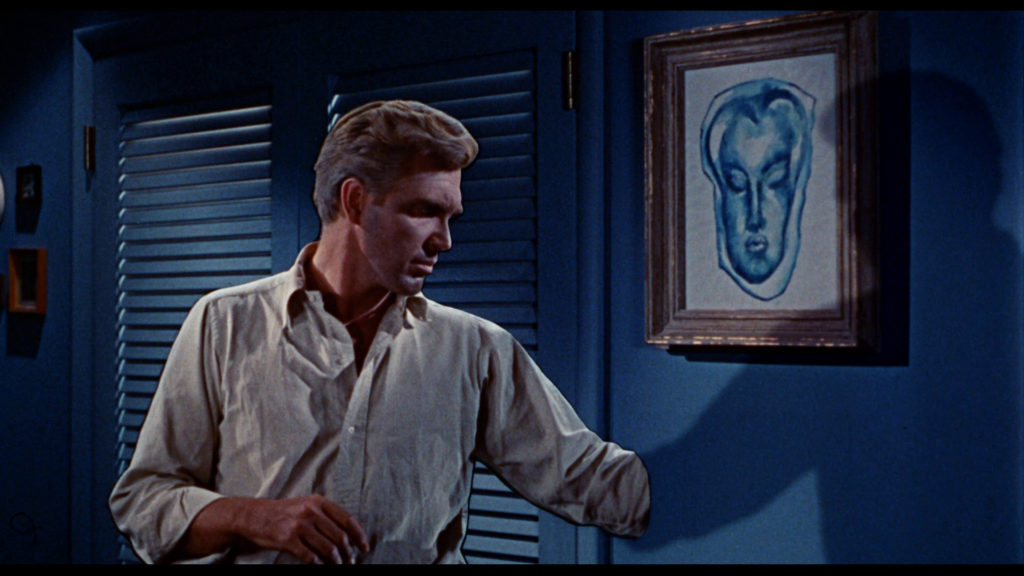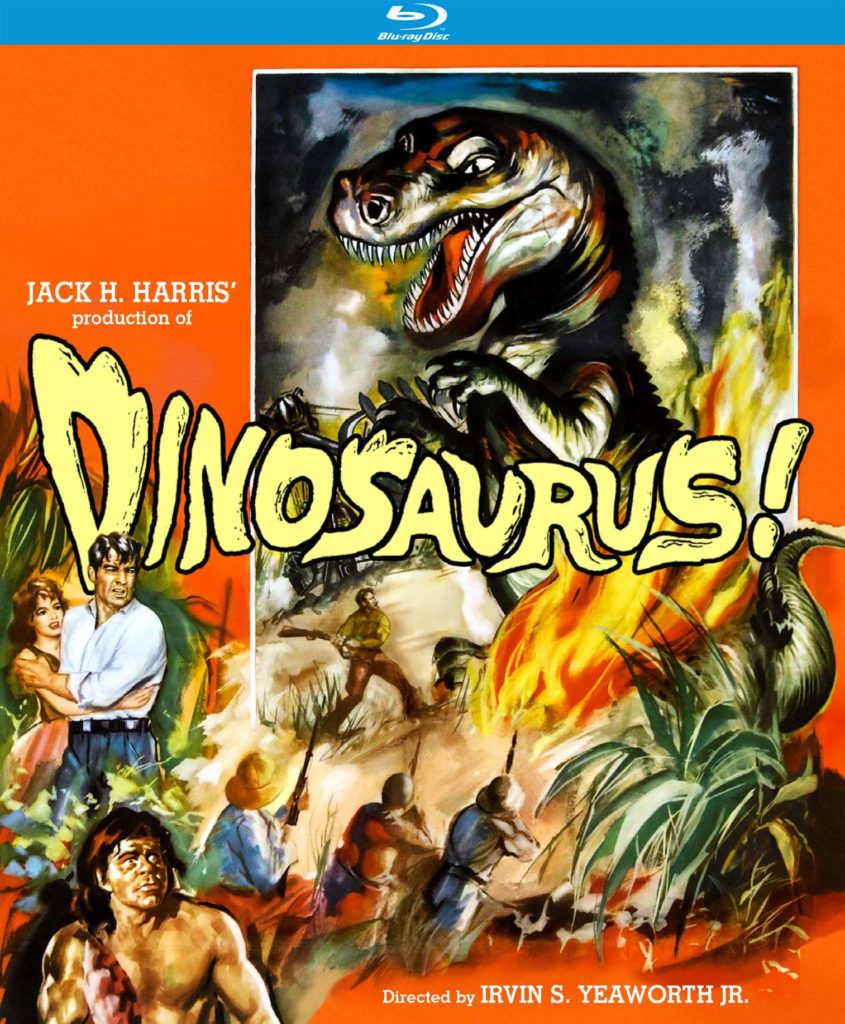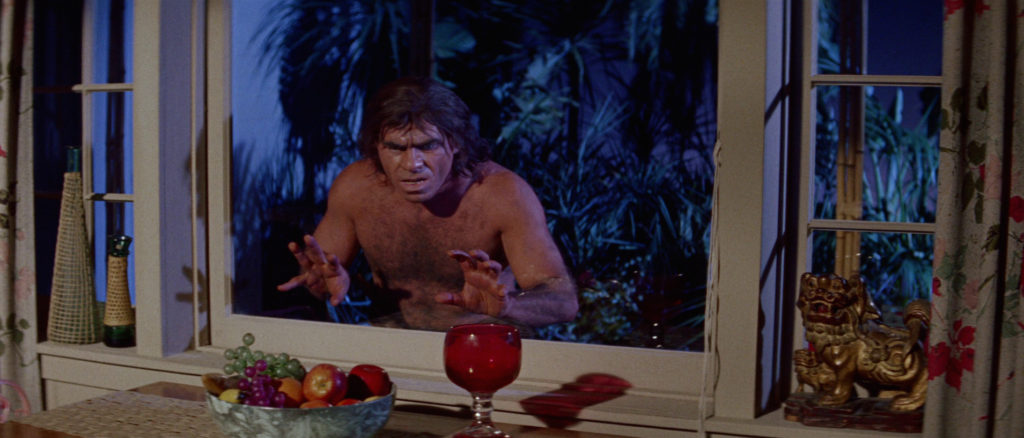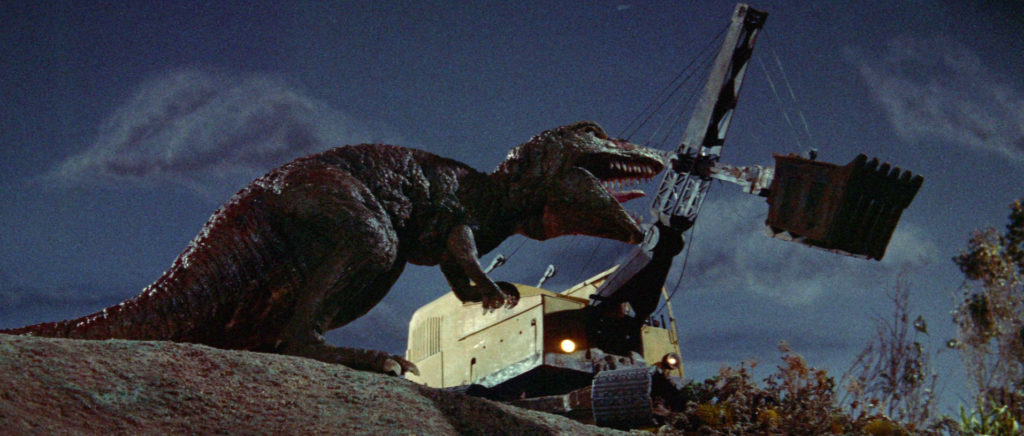Dimensional Shenanigans and Prehistoric Schlock In Two Harris-Yeaworth Flicks
4D MAN
DIRECTED BY IRVIN S. YEAWORTH, JR./1959
STREET DATE: AUGUST 20, 2019/KINO LORBER STUDIO CLASSICS

On the heels of The Blob, which technically had no heels, producer Jack Harris and director Irvin Yeaworth rolled its respectable profits into another project, this one less beholden to the popular monster-on-the-loose fad and more toward the headier sci-fi climes of hubristic dimensional meddling and Cain-and-Abel style bro-on-bro jealousy. Most noticeably ported over from the Blob formula are 1) a hip, jazzy soundtrack, in both cases provided by the prolific Ralph Carmichael, and 2) the brooding edginess of its lead – Steve McQueen in The Blob, and here, new-to-film brow-scruncher Robert Lansing, his nibs the 4D Man.
Tony Nelson (James Congdon) is convinced that everything on earth is permeable at the atomic level, so he uses his machine-electrified mind to try and push a pencil through a small block of metal. He did it once before, but this time he burns down his lab, so he turns for work to his brother, Scott (Lansing), employed by big shot industry types to perfect “cargonite” – the world’s most indestructible metal. Right away the metaphoric opposites are in place: brothers at odds, one the irresistible force of humor, charm, and transparent good will (Congdon is an off-the-rack James Garner), the other steel-thick with secrets and simmering hostility.

The necessary instigator in the middle of this is Scott’s lab assistant and fiancée, Linda (Lee Meriwether, post-Miss America, pre-Catwoman). When Scott sees Tony and Linda getting all the banter and goo goo eyes and sudden rain storms, he’s scientist enough to recognize the chemistry and broods it deep down into the film’s dominant subtext. Unfortunately, 4D Man is typical of its time: watching Meriwether’s Linda is like watching a modern woman trapped in the amber of institutionalized sexism. She doesn’t get two minutes into the film without a fellow lab worker asking her on a date and her character, while dominating in some ways (it’s Meriwether’s unblinking eyes that seem above it all), she’s often rendered automatonic by a script that requires her to play the inciting spoiler to nudge Scott into desperation – it’s the shallow purchase of story at the usual expense of the female character’s integrity. Even so, the depth of the resulting interpersonal romantic dynamics is more than you’d expect in a film of this assumed caliber, up there with the unexpected treatise on doomed marriage that is, of all things, The Creature Walks Among Us (1956).

Scott’s romantic desperation dominoes into a reckless attempt to conquer the pencil-in-metal trick himself – sort of a quid-pro-quo, you take my gal, I take your world-changing experimental breakthrough. And he does it. But he does it too well, and soon he’s passing through walls like Caspar the methody ghost. On its face, it’s all some far-fetched and silly stuff, but Yeaworth handles it fairly well, especially using that swinging, often insistent jazz, so unusual for science fiction, to underscore the suddenly unseated tension between the two brothers, and also framing the sequences depicting Tony and Linda’s burgeoning romance with a lot of borrowed charm from European cinema that doesn’t quite work but neither does it completely fall flat when it hits the baked-in hokum of American sci-fi tropes.
The characters are dwelt on long enough that most of the necessary sci-fi fodder is grounded in actual emotions. There’s a fine moment of panic, then diabolical readjustment, when Scott realizes late in the story that he has to use greater mind control just to touch or hold on to things, rather than just to make the magic trick work, and the mad pursuit of this forced power surge is like a drug rush. Like other accidental geniuses in film (Dr. Morbius in Forbidden Planet, Ed Avery in Bigger Than Life), the acquisition of greater brain power and intelligence has created an egomaniacal monster of the mind.

Hovering above all this is the nagging question…4D? Isn’t the fourth dimension just time? And what’s that got to do with any of this? Turns out Scott’s rampant brick-n-mortar osmosis (he progressively slips into a bar unnoticed, robs a locked bank vault, and kills his condescending boss in the old man’s home) is actually powered by his mind’s mysterious ability to compress decades into short bursts of time, the result of which is years taken off his life and gray hair added to his scalp. But these years are added back, he discovers, by simply transferring re-expanded time into whatever hapless victim is around to touch. For starters and quite by accident, he zaps his young doctor but good, and the poor guy keels over, a sudden man of 90, dying of “natural causes.” Ultimately, one gets the feeling the title sounded cool, then this eventual concept got shoehorned in for the sake of titular fidelity, when the original concept alone, and the audience’s simple expectations for this sort of fare, would fully justify the development of Scott’s murderous ego.
It’s a dog-pile of ideas in too short a movie, but too many ideas is better than no ideas at all. And by the time the same Harris-Yeaworth team developed Dinosaurus! a year later, they were apparently tapped out.
DINOSAURUS!
DIRECTED BY IRVIN S. YEAWORTH, JR./1960
STREET DATE: AUGUST 20, 2019/KINO LORBER STUDIO CLASSICS

The plot’s not terrible, in terms of low budget monster movies of the time. A crew working with explosives to expand a lagoon on a Caribbean island unearth two frozen dinosaurs and a Neanderthal. They lay on the beach inert, until a Frankensteinian bolt of lightning defibs their prehistoric guts and they rise again to terrorize the locals. There’s a young boy, Julio, who befriends both the brontosaurus and the caveman. He’s the surrogate for the intended demographic, but he’s not a good actor, especially when uttering spit-draft dialogue like, “Boy, you sure are one terrific caveman, you know that?” Occasionally the movie goes for humor, mostly via the caveman, whose exploration of a modern island home becomes his journey of self-discovery – trying on dresses, looking at himself in a mirror – that finally descends into lampoon when the humans arrive and he weaponizes some pie.

The movie is not without its fans, and the film-specific interview with late-producer, Harris, reflects an unironic appreciation for his own work. But the difference between Dinosaurus! and 4D Man is the difference between people just talking and actual character building, a deficiency here that barely manages 1D. When there’s no depth and things just happen, a kind of malaise descends. To be backhandedly fair, the poor effects and thin plotting are par for the course for this kind of movie. But the biggest sin in Dinosaurus! (besides an exclamation point that promises but fails to deliver some prehistoric song and dance) is how it plays down to kids. Even a movie like Jack the Giant Killer, just a couple of years later, with its ripped-off story and sub-Ray Harryhausen effects, at least takes itself seriously, never intentionally coaxing the silly. In fact, if the high bar for this kind of thing is the Harryhausen canon, with its kid-friendly but adult-serious tone, one that allows children to be enveloped into another world easily tethered by a natural sense of compassion for giant animals in distress, then this movie falls eons behind.

The films are presented beautifully on Kino Lorber’s Blu-ray upgrades, both receiving 4K restorations. Kris Yeaworth, the director’s son, spends much of the running time of Dinosaurus! expressing his gobsmacked surprise at how good it looks after all these years. He also provides a commentary on 4D Man, both solo, and brings a nostalgic flair with first-hand anecdotes of his childhood running around his dad’s “office”, in this case his pop’s 160-acre production studio complex in rural Chester Springs, Pennsylvania, where The Blob, 4D Man, and hundreds of religious films were made. (The story behind the making of Yeaworth’s small Christian empire would make a fine movie itself.) The great film historian Richard Harland Smith offers a more bird’s-eye view of 4D Man‘s production, with a fair mixture of biographical info, historical context, and literate film analysis that lifts the movie out of mere Saturday afternoon channel grazing and up into the echelon of smart-and-fun, like Smith himself. If you have the opportunity to see two Harris-Yeaworth joints, back up one and watch The Blob and 4D Man. Leave Dinosaurus! to the ancient past.
Images courtesy of dvdbeaver.com.

